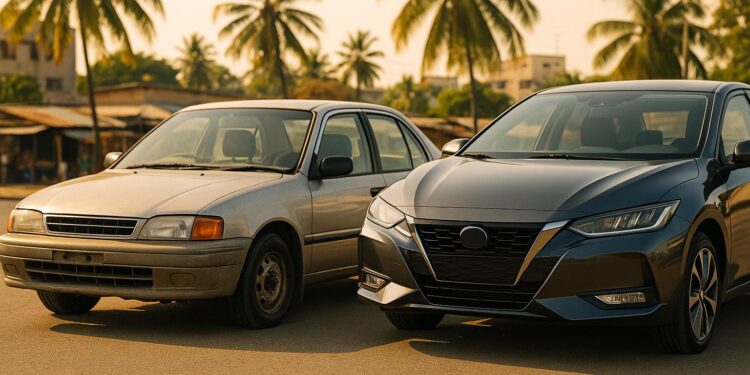Thinking about buying a car in Tanzania? Here’s what you need to know: used cars dominate the market due to their lower upfront cost, while new cars are gaining traction among higher-income buyers. Import duties, engine size, and country of origin heavily influence prices for both options.
- Used cars are more affordable, with slower depreciation and lower insurance costs. Maintenance can vary depending on age and parts availability.
- New cars offer warranties, modern features, and reliability but come with higher initial costs and rapid depreciation.
Quick Comparison
| Factor | Used Cars | New Cars |
|---|---|---|
| Price | Lower upfront cost | Higher due to taxes and fees |
| Depreciation | Slower | Rapid in the first few years |
| Reliability | Depends on condition | High, with warranty coverage |
| Maintenance | Can be unpredictable | Predictable during warranty |
| Insurance | Lower premiums | Higher premiums |
Your choice depends on your budget and priorities. If affordability and resale value matter most, a used car is the way to go. For long-term reliability and modern features, a new car might be worth the investment.
Used Cars form Japan – These 5 Cars RULE Africa in 2025!
1. Used Car Market
Tanzania’s used car market is bustling with a variety of imports from countries like Japan, the UK, and South Africa. Buyers can find a wide selection of models that fit different budgets, making it an appealing option for many.
Price Ranges
Prices for used cars in Tanzania depend on factors like the car’s age, condition, and where it was imported from. Compact cars tend to be more affordable, while mid-size sedans, SUVs, and newer luxury models come with a higher price tag. Engine size also plays a role, as vehicles with smaller engines are often cheaper due to favorable import duty regulations.
Value for Money
For many, used cars offer great reliability at a reasonable price. Japanese brands, in particular, stand out for their durability and strong resale value. Hybrid models, while initially pricier, can save money in the long run thanks to their fuel efficiency.
Affordability
The market serves a wide range of income levels. While cash purchases are common, local banks and microfinance institutions also provide financing options, making car ownership more accessible to a broader audience.
Ownership Costs
The cost of maintaining a used car depends on its age and how easily spare parts can be sourced. Japanese models are often easier and cheaper to maintain due to the availability of parts and mechanics familiar with these vehicles. Insurance costs are generally lower for used cars because of their depreciation, but older cars might need more frequent servicing and inspections. These factors make it easier to weigh the pros and cons of choosing a used car over a new one.
2. New Car Market
Tanzania’s new car market caters to a niche audience, primarily those looking for vehicles with solid warranties, cutting-edge features, and dependable performance. Leading brands like Toyota, Nissan, Hyundai, and Suzuki dominate the market, with authorized dealerships concentrated in major hubs such as Dar es Salaam and Arusha. Let’s explore how pricing, value, affordability, and ownership costs shape this market.
Price Ranges
New cars in Tanzania come with a hefty price tag, largely due to high import duties and taxes. Even entry-level models are priced at a premium, and costs increase significantly for mid-range sedans, SUVs, and luxury vehicles.
Value for Money
New vehicles often include perks like comprehensive warranties, advanced safety systems, better fuel efficiency, and modern infotainment setups. These features provide peace of mind for buyers. However, new cars tend to lose value quickly during the first few years of ownership. This depreciation is particularly relevant in Tanzania, where there’s a strong preference for quality used imports.
Affordability
Although new cars provide excellent features, buying one requires a substantial financial outlay. Large down payments are typically necessary, and while local banks do offer auto loans, strict lending requirements can make financing difficult for many. As a result, the new car market largely serves expatriates, business owners, and high-income professionals. Some buyers opt for corporate leasing or company vehicle programs to manage these high costs more effectively.
Ownership Costs
Owning a new car ensures reliable maintenance through authorized service centers that use genuine parts, often covered under warranty. However, ownership expenses can add up quickly due to higher insurance premiums and registration fees, which are calculated based on factors like engine size and the vehicle’s overall value.
sbb-itb-d9186c2
Used vs New Cars: Advantages and Disadvantages
When deciding between a used car and a new one, it often comes down to cost, reliability, and long-term ownership expenses. Here’s a closer look at how these two options stack up.
Used cars are typically easier on the wallet. Their lower purchase price makes them an attractive choice for budget-conscious buyers, and they depreciate at a slower rate compared to new cars. This means their value holds steadier over time, which can be a big plus if you plan to resell.
That said, used cars aren’t without their challenges. Reliability can be a gamble, especially if the previous owner didn’t stay on top of maintenance. Repairs might pop up unexpectedly, and sourcing parts for older or less common models can sometimes be tricky – and costly. Without a warranty, any mechanical hiccups fall squarely on the owner’s shoulders.
New cars, on the other hand, come with the peace of mind that a comprehensive warranty provides. This reduces early repair worries and ensures access to authorized service centers that use genuine parts. Plus, they often boast the latest in safety features, better fuel efficiency, and cutting-edge technology, making for a safer and more enjoyable ride.
The downside? New cars lose value quickly. Depreciation hits hardest in the first few years, which can impact their long-term value. And, of course, the higher upfront cost can put them out of reach for some buyers.
Here’s a side-by-side breakdown:
| Factor | Used Cars | New Cars |
|---|---|---|
| Price | Lower initial cost, making ownership more affordable | Higher upfront cost, influenced by taxes and fees |
| Depreciation | Slower depreciation rate | Rapid depreciation in the first few years |
| Reliability | Depends on the vehicle’s history | High reliability, backed by a manufacturer warranty |
| Maintenance | Potentially higher repair costs | Predictable costs during the warranty period |
| Insurance | Lower premiums based on the car’s current value | Higher premiums due to the car’s higher value |
| Financing | Easier approval with smaller loans | Stricter financing due to higher purchase price |
When it comes to maintenance, used cars might hit you with occasional, unexpected repair bills, while new cars generally offer predictable costs during the warranty period. However, once a new car’s warranty expires, maintenance at authorized service centers can get pricey.
Resale value is another area where the two differ. New cars take a steep hit in value early on, but a well-maintained one could still fetch a decent price later. Used cars, having already absorbed most of their depreciation, can sometimes hold their value better – especially if the model is popular.
Ultimately, the choice boils down to your driving habits and financial priorities. If you rely on your car for daily commutes or business and value the reliability of a warranty, a new car might be worth the investment. On the other hand, if you don’t drive often or have other transportation options, a well-maintained used car could save you money while meeting your needs.
Conclusion
Tanzania’s vehicle market in 2025 presents a clear choice between used and new cars, each catering to different needs and budgets. Used cars continue to dominate the market, thanks to their lower upfront costs and slower depreciation, making them a practical option for a wide range of income levels.
For budget-conscious buyers, used vehicles offer an affordable entry into car ownership. However, they come with trade-offs, such as potentially higher maintenance expenses and less consistent reliability over time.
On the other hand, new cars attract buyers who value reliability, warranties, and modern features, even with their higher price tags. This option is ideal for those with stable, higher incomes who plan to use their vehicle heavily for business or daily commutes, prioritizing long-term dependability.
For budget buyers, focusing on popular used models with readily available parts and a strong service network can help offset the challenges of owning a used car. This strategy ensures better value and a smoother ownership experience.
FAQs
What should I think about when choosing between a used or new car in Tanzania?
When choosing between a new or used car in Tanzania, there are several important factors to consider. Let’s start with cost – used cars often have a lower upfront price, but don’t forget to factor in taxes and import duties. These can range from 32% to 65% of the car’s value, significantly impacting the final price for both new and used vehicles.
Another key point is maintenance. While used cars might save you money initially, they often require more frequent repairs. On the other hand, new cars usually come with warranties and lower upkeep costs, which can save you headaches down the road.
Then there’s fuel expenses, which can add up over time. As of May 2025, gas prices in Tanzania hover between $1.14 and $1.17 per liter, so fuel efficiency is an important factor to keep in mind. Lastly, consider the age of the vehicle. Newer cars (typically those between 0-5 years old) often come with better features, improved fuel efficiency, and fewer maintenance issues. For buyers looking for long-term value, these advantages make newer cars an appealing option.
How do import taxes influence the cost of new and used cars in Tanzania?
Import taxes significantly influence the cost of both new and used cars in Tanzania. The tax rates, which depend on the vehicle’s engine size and type, can range from 32% to 65% of the car’s value. Vehicles with larger engines, particularly those exceeding 2,000cc, face higher tax rates.
The overall tax includes import duty, VAT, and excise duty, with the excise duty specifically tied to engine size. These taxes make imported vehicles, especially newer or larger models, considerably more expensive. This is an important factor to keep in mind when planning your car purchase in Tanzania.
What financing options are available for buying a car in Tanzania, and how do they vary for new and used vehicles?
Financing a car in Tanzania generally involves three main options: bank loans, dealership financing, and personal savings. The specifics of these options can vary depending on whether you’re buying a new or used vehicle.
When it comes to new cars, banks and dealerships often provide loans with more appealing terms. These can include lower interest rates and extended repayment periods, as new vehicles are seen as lower-risk investments. Some dealerships even offer in-house financing plans, allowing buyers to spread payments over time.
For used cars, financing tends to come with slightly higher interest rates or shorter repayment periods. This is because pre-owned vehicles are associated with higher depreciation and greater risk. That said, used cars usually cost less upfront, which might mean smaller loan amounts – or even the chance to pay in full without financing.
To get the best deal, it’s essential to review and compare the terms of different financing options to ensure they align with your financial situation and goals.
Related Blog Posts
- New vs. Used Cars: What First-Time Buyers Should Know
- Best used cars in Tanzania 2025
- Car prices in Dar es Salaam
- Car Prices in Tanzania in 2025: What’s Affordable Now?




